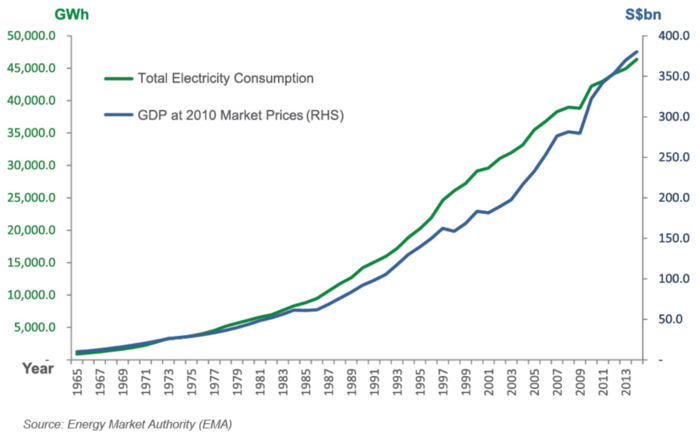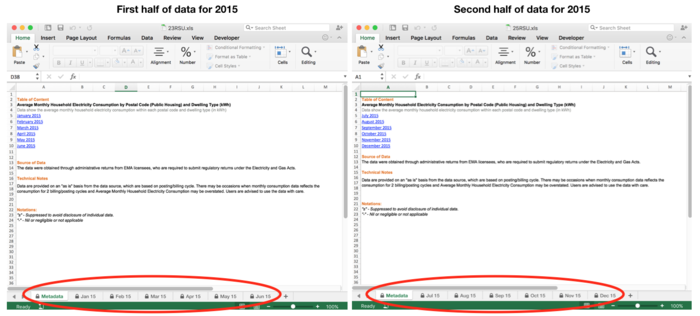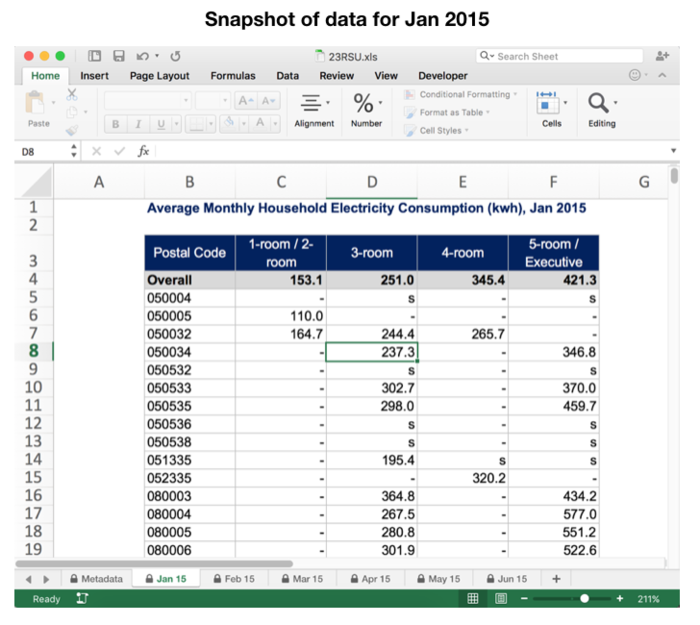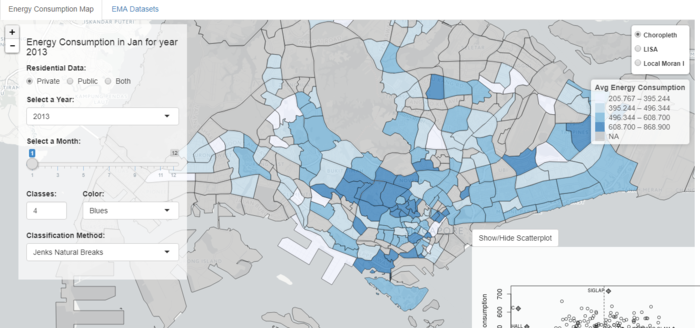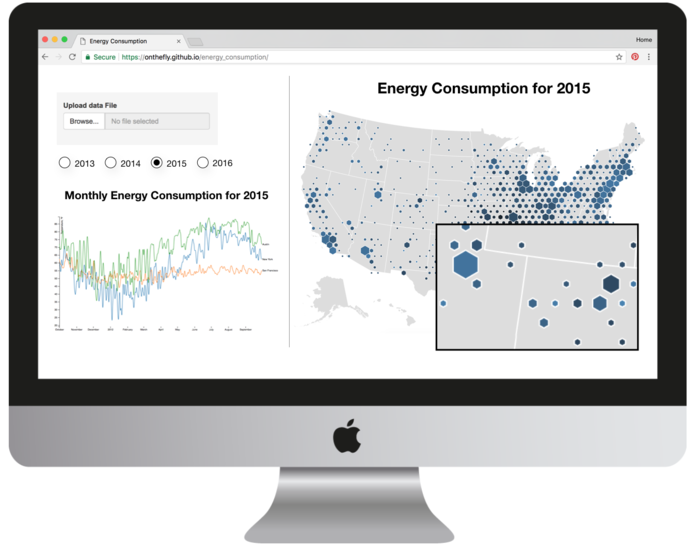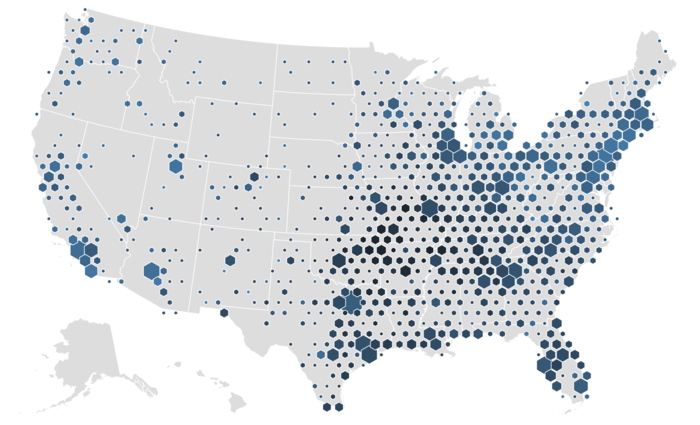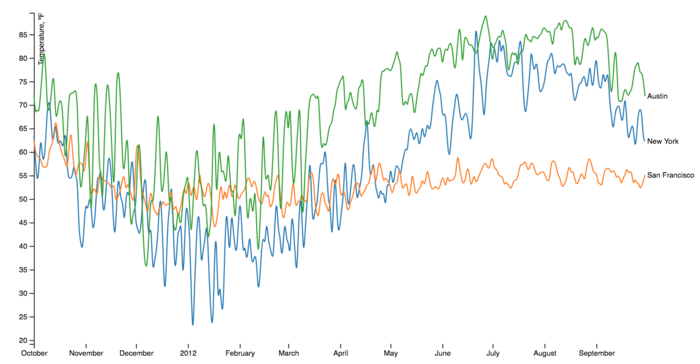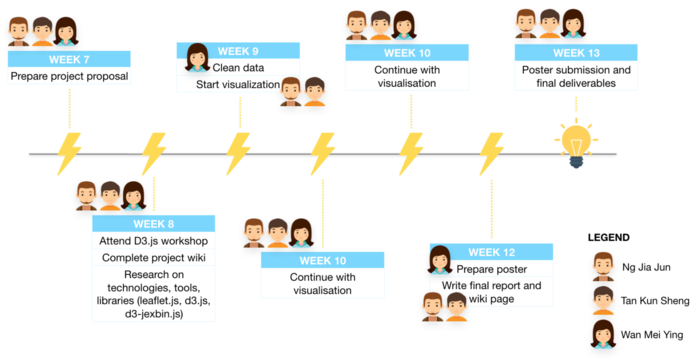1718t1is428T15
|
PROJECT PROPOSAL |
Contents
Project Motivation & Objective
Experts have warned that power demand is set to double by 2030 globally despite authoritative control. High power consumption can already be observed locally. According to the Energy Market Authority (EMA), Singapore has faced increasing power consumption from 1965 to 2013 [1].
As Singapore is land-scarce and does not have significant renewable energy options such as hydro-power, wave, or sufficient land for mass solar energy production, energy has been a top concern in the urban nation[2]. It is thus important to promote energy saving concepts to the public as well as deploying energy saving solution island wide. However, the usual analysis tools are not enough to provide a different perspective to facilitate the deployment of the solution. Information about the energy consumption levels of residents in Singapore are often not conveyed adequately enough in data visualisation. While EMA and Singstat provide annual data and reports on energy usage in Singapore, a powerful visualisation technique should be used to gain insights effectively. Our team aims to create a visualisation that leverages on energy datasets provided by EMA to perform spatial analysis to identify energy usage clusters with hexagonal binning.
Dataset
Data Source
The analysis will be based on EMA dataset[3]:
- Public housing's monthly average household electricity consumption (kwh) (2013 - 2015)
- Private apartment's monthly average household electricity consumption (kwh) (2013 - 2015)
The dataset for each year is split into two excel workbooks, each containing six sheets representing each month's data as shown above.
The above is a snapshot of Jan 2015's energy consumption data for public housing.
Data Attributes
Public Housing
- Postal code
- 1-room
- 2-room
- 3-room
- 4-room
- 5-room/executive
Private Apartment
- Postal code
- Jan
- Feb
- Mar
- Apr
- May
- Jun
- Jul
- Aug
- Sep
- Oct
- Nov
- Dec
Related Works
Much of the relevant prior work on residential energy consumption levels in Singapore revolve around the motivations and barriers towards energy efficiency.
In 2013, the Ministry of the Environment and Water Resources (MEWR) interviewed 2,500 residents on their extent of energy efficiency practice at home, level of awareness of energy efficiency, and barriers towards being energy efficient. It found that 41.3% of the respondents are more encouraged to conserve electricity if the government were to provide monetary incentives or voucher rewards/rebates, and 36.5% are motivated by advertisements on various media platforms. The findings also concluded that residents generally perceived the high cost of energy-efficient appliances and inconvenience of energy-saving practices as barriers to energy efficiency in households.[4]
Another research by Energy Efficient Singapore (E2 Singapore) indicated that when residents in other countries are allowed to compare their utility bills against that of their neighbours, they can potentially achieve 4 to 12% energy savings. This is because it leverages on the power of social norms to provide direct feedback to the residents – residents are likely to bring their behavior closer to the norm when they are informed of what the norm is.[5]
A third by Xu and Ang from NUS analyzes the root cause of high energy consumption using the index decomposition analysis (IDA). The IDA model studies changes in energy consumption over time and is often used in major energy consuming sectors such as the transport industry. To fit the model for use on the residential sector, Xu and Ang applied a hybrid IDA model that divides the residential sector into various subsectors, each with a different key factor driving energy consumption. For instance, energy consumption in a subsector may be driven by floor area (for air cooling and heating). The paper found that environment control and household appliances are the main factors for energy consumption by households, and each of these is greatly affected by population growth and decreases in residents per household.[6]
By using our proposed work jointly with the first two papers, users can visually identify clusters with high energy usage where efficient energy consumption measures can be implemented. With the last paper, we can trace the root cause for high energy usage.
Inspirations
The number of public and private address points in Singapore is exceptionally large at about twenty thousands records. While this may pale in comparison to data sets that amount to tens of millions of records in size, the real challenge lies in plotting these points over a geographical region as small as Singapore. The limitation in land space coupled with the immense number of data points would result in many overlapping and cluttering of address points, making data aggregation and visualizing energy consumption extremely difficult and ineffective.
Our team has already experimented aggregating energy consumption levels onto a choropleth map segmented by planning areas. This approach is effective in providing an overview of energy consumption levels across planning areas in Singapore, further assisting analysis in local indications of spatial correlation in terms of energy usage clustering. However, this approach is inept at investigating clustering at finer levels of spatial granularity, focusing on smaller areas is impossible as data is aggregated at the level of planning areas.
With this in mind, On The Fly is experimenting with an alternative technique of hexagonal binning for visualizing energy usage density of public and private housings. By aggregating the number of address points into hexagons and computing the average energy consumption of address points in these hexagons, we aim to visualize energy consumption levels of address points aggregated across smaller areas in hex bins to generate a more detailed view of energy usages across geographical land space.
Proposed Storyboard
Upload Data
An interface will be provided for the user to upload datasets of past and/or future years. This would provide more flexibility for users to analyze a wider range of energy usage data.
Hexagon Binning
There are many levels that we can consider when thinking of how to analyze the intensity of energy consumption in Singapore, such as on a national level, regional level, or subzone level. But these levels are too coarse and does not provide a comprehensive view - for instance, a large subzone would surely have a higher energy consumption level since there are more residents living in it.
Thus, to properly analyze the intensity of energy consumption in Singapore, we need to do so on a more granular level; We decide to break down Singapore into various groups of postal codes. By aggregating a few postal codes together, we have a higher chance of uncovering new findings.
The best way to visualize this would be to plot hexagon bins (“hexbins”) onto the Singapore map, with each hexbin representing a group of postal codes, and using a gradient colour scheme to represent each group’s energy consumption intensity.
Line Chart
We will add in a multi-series line chart to allow users to compare the monthly energy consumption levels by: 1) entire Singapore, 2) a group of postal codes, and 3) each postal code.
The default line chart would show only the average monthly consumption of the entire nation. Upon clicking on a single hexbin, the line chart would populate another series to show the average monthly consumption by the group of postal codes within that hexbin. The clicking would also trigger the pop-out of a second map which features a zoomed in view of the hexbin, displaying the separate postal codes within the hexbin. Clicking on any points on the pop-out map would result in a third series, representing a single postal code, to be displayed on the line chart.
Technical Challenges
| Key Technical Challenges | How We Propose To Resolve |
|---|---|
| |
| |
|
Timeline
Technologies/Tools
The following are technologies and tools which we used:
- Microsoft Excel (data cleaning)
- d3.js (visualisation)
- Leaflet.js (overlaying of map)
- d3-hexbin.js (overlaying of hexagonal bins, wrapper library of d3 and leaflet)
- Github (version control)
Reference
- ↑ https://www.ema.gov.sg/Publications_Annual_Reports.aspx
- ↑ http://www.eco-business.com/news/tackling-energy-challenges-the-singapore-way/
- ↑ https://www.ema.gov.sg/Statistics.aspx
- ↑ https://www.mewr.gov.sg/docs/default-source/default-document-library/grab-our-research/mewr_ee_report.pdf
- ↑ http://www.e2singapore.gov.sg/DATA/0/docs/NewsFiles/Find%20out%20how%20much%20your%20neighbours%20spend%20on%20energy_v2.pdf
- ↑ http://www.e2singapore.gov.sg/DATA/0/docs/1-s2.0-S0306261913006193-main.pdf
Comments

